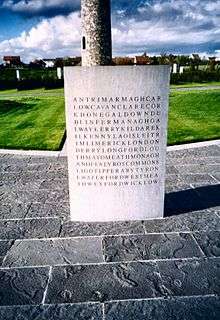16th (Irish) Division
| 16th (Irish) Division | |
|---|---|
_Division_Insignia.png) | |
| Active | 1914–1919 |
| Country |
|
| Branch |
|
| Type | Infantry |
| Size | Division |
| Engagements |
World War I: Spring Offensive |
The 16th (Irish) Division was an infantry division of the British Army, raised for service during World War I. The division was a voluntary 'Service' formation of Lord Kitchener's New Armies, created in Ireland from the 'National Volunteers',[1] initially in September 1914, after the outbreak of the Great War. In December 1915, the division moved to France, joining the British Expeditionary Force (BEF), under the command of Irish Major General William Hickie, and spent the duration of the war in action on the Western Front. Following enormous losses at the Somme, Passchendaele and Ypres, the 16th (Irish) Division required a substantial refit in England between June and August 1918, which involved the introduction of many non-Irish battalions.
History
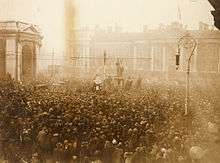
Moved by the fate of Belgium, a small and Catholic country, John Redmond had called on Irishmen to enlist "in defence of the highest principles of religion and morality and right". More Catholic Irish enlisted than Protestants.[2]
The 16th Division began forming as part of the K2 Army Group towards the end of 1914 after Irish recruits in the early days of the war from England and Belfast first filled the ranks of the 10th (Irish) Division before being assigned to the 16th Division,[3] formed around a core of National Volunteers.[3] Initial training began in Ireland at Fermoy,[4] Munster; recruits also trained at Buttevant. The division moved to Aldershot in Hampshire, England for more intensive training in September 1915. After thirteen weeks, the division was deployed to Étaples in France, joining the British Expeditionary Force (BEF), then commanded by Field Marshal Sir John French, but later replaced by General Sir Douglas Haig. From there the division left on 18 December for that part of the front in the Loos salient, under the command of Irish Major General William Hickie and spent the rest of the war on the Western Front.
Until March 1916 the 16th Division was part of IV Corps, commanded by the staunch unionist, Lieutenant General Sir Henry Wilson. Wilson, who had called the division "Johnnie Redmond's pets", inspected them over the course of a few days over Christmas 1915, noting that they "appear to be inferior" and that "at least 50p.c. are quite useless, old whiskey-sodden militiamen". Hickie agreed that he had "a political Divn of riff raff Redmondites". Wilson thought the 47th Brigade had "old officers, old & useless men, very bad musketry, rotten boots, and altogether a very poor show". Wilson reported to the Army Commander, Lieutenant General Sir Charles Monro (6 January) that the division, despite having been training since September–October 1914, would not be fit to serve in an active part of the line for six weeks. Although–in the opinion of Wilson's biographer Keith Jeffery–political prejudice probably played a part in these views, Wilson also attributed much of the difference in quality between his divisions to training, especially of officers, in which he took a keen personal interest, opposing Haig's wish to delegate training from corps to division level.[2] Hickie was–in public–much more diplomatic and tactful and spoke of the pride which his new command gave him.[5]
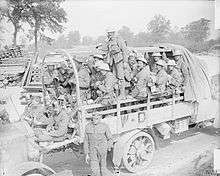
At Loos, in January and February 1916, the division was introduced to trench warfare and suffered greatly in the Battle of Hulluch, 27–29 April, (during the Easter Rising in Ireland). Personnel raided German trenches all through May and June.[6] In late July they were moved to the Somme Valley where they were intensively engaged in the Battle of the Somme. Lieutenant General Hubert Gough, the British Fifth Army commander, had asked, at the end of 1915, for the division to be placed under his command, and had established the first corps school for the training of young officers.[7] The 16th Division played an important part in capturing the towns of Guillemont and Ginchy, although they suffered massive casualties. During these successful actions between 1 and 10 September casualties amounted to 224 officers and 4,090 men; despite these very heavy losses the division gained a reputation as first-class shock troops.[8] Out of a total of 10,845 men, it had lost 3,491 on the Loos sector between January and the end of May 1916, including heavy casualties from bombardment and a gas attack at Hullach in April. Bloodletting of this order was fatal to the division's character, for it had to be made good by drafts from England.[6]
In early 1917, the division took a major part in the Battle of Messines alongside the 36th (Ulster) Division, adding to both their recognition and reputation. Their major actions ended in the summer of 1917 at the Battle of Passchendaele after, again, coming under the command of Gough and the Fifth Army. In July 1917, during the Third Battle of Ypres, although both divisions were completely exhausted after 13 days of moving weighty equipment under heavy shelling, Gough ordered the battalions to advance through deep mud towards well fortified German positions left untouched by totally inadequate artillery preparation.[9] By mid August, the 16th had suffered over 4,200 casualties, the 36th almost 3,600, or more than 50% of their numbers. Haig, now a field marshal, was very critical of Gough for "playing the Irish card".[10]
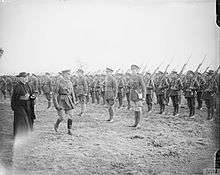
The 16th Division held an exposed position from early 1918 at Ronssoy where they suffered more heavy losses during the German Army's Spring Offensive in March and being practically wiped out in the retreat which followed Operation Michael.[11] Haig wrote in his diary (22 March 1918) that the division was "said not to be so full of fight as the others. In fact, certain Irish units did very badly and gave way immediately the enemy showed". In fact the division's casualties were the highest of any BEF division at this time, and records of the German 18th and 50th Reserve Divisions show that the Irish fought hard.[12] The corps commander, Lieutenant General Walter Congreve, wrote "the real truth is that their reserve brigade did not fight at all and their right brigade very indifferently". One battalion was greeted at the rear with cries of "There go the Sinn Feiners!" A report by Field Marshal Sir Henry Wilson, now the Chief of the Imperial General Staff (CIGS), concluded that there was no evidence that the men had not fought well, but pointed out that only two-thirds of the men were of Irish birth. The matter affected the debate over the introduction of conscription of Ireland.[13]
The remnants of the division were later transferred to XIX Corps of the Third Army.[14] The 16th helped to finally halt the German attack prior to the Battle of Hamel. The decision was then made to break up the division, the three surviving Service battalions were posted to other formations.[11]
On 14 June the division returned to England for "reconstitution". The Conscription Crisis of 1918 in Ireland meant that fewer Irish recruits could be raised so that the 16th Division which returned to France on 27 July contained five English battalions, two Scottish battalions and one Welsh battalion. The only original battalion left was the 5th Royal Irish Fusiliers.
The dispersion of the Irish battalions throughout the BEF in 1918, despite its practical considerations, appears to suggest that the Irish units were increasingly distrusted by the military authorities.[15]
Order of battle
The 16th Division was composed of the following during World War I:
- 8th (Service) Battalion, Royal Munster Fusiliers (New Army) (disbanded November 1916)
- 6th (Service) Battalion, Royal Irish Regiment
- 7th (Service) Battalion, Prince of Wales's Leinster Regiment (Royal Canadians); (disbanded February 1918)
- 6th (Service) Battalion, Connaught Rangers (until June 1918)
- 1st Battalion, Royal Munster Fusiliers (from November 1916 until April 1918)
- 18th (Service) Battalion Welsh Regiment (2nd Glamorgan), (from May 1918)
- 14th (Service) Battalion, Leicestershire Regiment (from June 1918)
- 9th (Service) Battalion, Black Watch (Royal Highlanders) (from July 1918)
- 2nd Battalion, Leinster Regiment (from February 1918 until April 1918)
- 47th Machine Gun Company, Machine Gun Corps (joined 28 April 1916, moved to 16th Battalion, Machine Gun Corps 9 March 1918)
The 47th Brigade was known as the "Nationalist Brigade" as the majority were men from Redmond's Irish Volunteers. The four original battalions were;- 6th Royal Irish Regiment, 6th Connaught Rangers, 7th Leinster Regiment and 8th Royal Munster Fusiliers. They, with the 20th (Light) Division, captured Guillemont on the Battle of the Somme on 3 September 1916.[16] Six days later, with the rest of the 6th Division, captured Ginchy.
- 9th (Service) Battalion, Royal Munster Fusiliers (New Army) (disbanded May 1916)
- 7th (Service) Battalion, Royal Irish Rifles (until August 1917)
- 8th (Service) Battalion, Royal Dublin Fusiliers (merged with 9th Battalion October 1917)
- 9th (Service) Battalion, Royal Dublin Fusiliers (merged with 8th (Service) Battalion October 1917)
- 1st Battalion, Royal Munster Fusiliers (from May 1916 until November 1916)
- 1st Battalion, Royal Dublin Fusiliers (from October 1917 until April 1918)
- 2nd Battalion, Royal Munster Fusiliers (from February 1918 until May 1918)
- 22nd (Service) Battalion, Northumberland Fusiliers (from June 1918)
- 18th (Service) Battalion, Cameronians (Scottish Rifles) (from July 1918)
- 11th (Service) Battalion, Royal Irish Fusiliers (from June 1918 until August 1918)
- 5th (Service) Battalion, Royal Irish Fusiliers (from August 1918)
- 10th (Service) Battalion, Royal Dublin Fusiliers (from June 1917, disbanded February 1918)
- 48th Machine Gun Company (joined 28 April 1916, moved to 16th Battalion, Machine Gun Corps 9 March 1918)
The 8th and 9th (Service) Battalions of the Royal Dublin Fusiliers combined to form the 8/9th Battalion in October 1917 which was subsequently disbanded in February 1918.
- 7th (Service) Battalion, Royal Irish Fusiliers (merged with 8th (Service) Battalion October 1916, disbanded February 1918)
- 8th (Service) Battalion, Royal Irish Fusiliers (merged with 7th (Service) Battalion October 1916, disbanded February 1918)
- 7th (Service) Battalion, Royal Inniskilling Fusiliers (merged with 8th Battalion August 1917)
- 8th (Service) Battalion, Royal Inniskilling Fusiliers (merged with 7th (Service) Battalion August 1917)
- 2nd Battalion, Royal Irish Regiment (from October 1916 until April 1918)
- 7th (Service) Battalion, Royal Irish Rifles (from August 1917 until October 1917)
- 7th (Service) Battalion, Royal Irish Regiment (South Irish Horse) Battalion,(from October 1917 until July 1918)
- 34th (Service) Battalion, London Regiment (County of London) Battalion (from June 1918)
- 6th (Service) Battalion, Prince Albert's (Somerset Light Infantry)- (from July 1918)
- 18th (Service) Battalion, Gloucestershire Regiment (from July 1918)
- 49th Machine Gun Company, Machine Gun Corps (joined 29 April 1916, moved to 16th Battalion, Machine Gun Corps 9 March 1918)
The 7th and 8th Battalions of the Royal Irish Fusiliers combined to form the 7th/8th Battalion in October 1916 which was subsequently disbanded in February 1918. The 7th and 8th Battalions of the Royal Inniskilling Fusiliers combined to form the 7th/8th Battalion in August 1917 which was also subsequently disbanded in February 1918.
See also
Notes
- ↑ Grayson, Dr. Richard S.: Belfast Boys – How Unionists and Nationalists fought and died together
in the First World War, p.14, Continuum UK, London (2009) ISBN 978-1-84725-008-7 - 1 2 Jeffery 2006, pp 156-8
- 1 2 Grayson, Richard S.: pp.14-18
- ↑ Grayson, Richard S.: pp.16-18
- ↑ Irish Regiments in the Great War p. 119, Timothy Bowmann (2003) ISBN 0-7190-6285-3
- 1 2 Duffy, Christopher: Through German Eyes: The British & the Somme 1916 p.101, Phoenix of Orion Books (2007) ISBN 978-0-7538-2202-9
- ↑ Farrar-Hockley 1974, p176
- ↑ Murphy, David: Irish Regiments in the World Wars, The Irish Divisions, 1914-18: the 16th (Irish) Division pp.16-17, Osprey Publishing (2007) ISBN 978-1-84603-015-4
- ↑ Prior, Robin & Wilson, Trevor: Passchendaele, the untold story, "Gough, Rain" pp.102–05, (1997) ISBN 978-0-300-07227-3
- ↑ Prior & Wilson 1997, pp.102–05.
- 1 2 Bowman, Timothy: Irish Regiments in the Great War p.171, Manchester Uni. Press (2003) ISBN 978-0-7190-6285-8
- ↑ Farrar-Hockley 1975, p290
- ↑ Kitchen 2001, p245
- ↑ Kitchen 2001, p68
- ↑ Bowman, Timothy: p.176
- ↑ Ireland's Unknown Soldiers by Terence Denman and 148 Days on the Somme by Barry Cuttle.
Battles
- Battle of Hulluch
- Battle of the Somme (1916)
- Battle of Guillemont
- Battle of Ginchy
- Battle of Messines (1917)
- Third Battle of Ypres
Great War Memorials
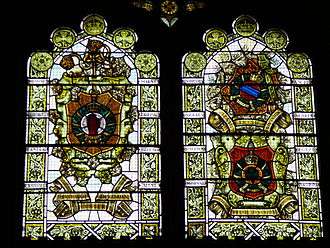
the Three Irish Divisions, left the 36th, right the 10th and 16th.
- Irish National War Memorial Gardens, Dublin.
- Island of Ireland Peace Park Messines, Belgium.
- Ulster Tower Memorial Thiepval, France.
- Menin Gate Memorial Ypres, Belgium.
References and further reading
- Bartlet, Thomas & Jeffery, Keith: A Military History of Ireland, Cambridge University Press (1996) (2006), ISBN 978-0-521-62989-8
- Bowen, Desmond & Jean: Heroic Option: The Irish in the British Army, Pen & Sword Books (2005), ISBN 978-1-84415-152-3.
- Cooper, Bryan (1918): The 10th (Irish) Division in Gallipoli, Irish Academic Press (1993), (2003). ISBN 978-0-7165-2517-2.
- Denman, Terence: Ireland's unknown Soldiers: the 16th (Irish) Division in the Great War, Irish Academic Press (1992), (2003) ISBN 978-0-7165-2495-3.
- Dooley, Thomas P.: Irishmen or English Soldiers? : the Times of a Southern Catholic Irish Man (1876–1916), Liverpool Press (1995), ISBN 978-0-85323-600-9.
- Dungan, Myles: They Shall not Grow Old: Irish Soldiers in the Great War, Four Courts Press (1997), ISBN 978-1-85182-347-5.
- Farrar-Hockley, General Sir Anthony (1975). Goughie. London: Granada. ISBN -0246640596.
- Grayson, Dr. Richard S.: Belfast Boys – How Unionists and Nationalists fought and died together
in the First World War, Continuum UK, London (2009) ISBN 978-1-84725-008-7 - Horne, John ed.: Our War 'Ireland and the Great War': The Thomas Davis Lectures, The Royal Irish Academy, Dublin (2008) ISBN 978-1-904890-50-8
- Jeffrey, Keith: Ireland and the Great War, Press Syndicate of the University of Cambridge (2000), ISBN 978-0-521-77323-2.
- Jeffery, Keith (2006). Field Marshal Sir Henry Wilson: A Political Soldier. Oxford University Press. ISBN 978-0-19-820358-2.
- Kitchen, Martin (2001). The German Offensives of 1918. Tempus, Stroud. ISBN 0-7524-1799-1.
- Moore, Steven: The Irish on the Somme (2005), ISBN 978-0-9549715-1-9.
- Murphy, David: Irish Regiments in the World Wars, OSprey Publishing (2007), ISBN 978-1-84603-015-4
- Murphy, David: The Irish Brigades, 1685-2006, A gazetteer of Irish Military Service past and present,
Four Courts Press (2007) The Military Heritage of Ireland Trust. ISBN 978-1-84682-080-9 - Prior, Robin & Wilson, Trevor. (1997). Passchendaele: The Untold Story. Yale University Press.
- Walker, Stephen: Forgotten Soldiers; The Irishmen shot at dawn Gill & Nacmillan (2007), ISBN 978-0-7171-4182-1
External links
- The Long, Long Trail: The 16th (Irish) Division in 1914-1918
- A website with information relating to the Royal Dublin Fusiliers who had battalions which were a part of the 16th (Irish) Division.
- The Long, Long Trail: Information relating to the Royal Munster Fusiliers (New Army) which was part of the 16th (Irish) Division
- The Battle for Messines Ridge
- Homepage of the Island of Ireland Peace Park Memorial
- The Irish War Memorials Project – listing of monuments throughout Ireland
- The Military Heritage of Ireland Trust
- Department of the Taoiseach: Irish Soldiers in the First World War
